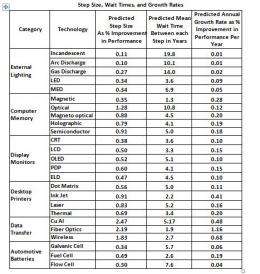Forget Moore's Law: Researchers define new ways to evaluate new technologies

The bread and butter of investing for Silicon Valley tech companies is stale. Instead, a new method of predicting the evolution of technology could save tech giants millions in research and development or developments of new products—and help analysts and venture capitalists determine which companies are on the right track.
The high-tech industry has long used Moore's Law as a method to predict the growth of PC memory. Moore's Law states that the number of chips on a transistor doubles every 18 months (initially every year). A paper by Gareth James and Gerard Tellis, professors at the USC Marshall School of Business and their co-authors Ashish Sood, at Emory and Ji Zhu at the University of Michigan, concludes that Moore's Law does not apply for most industries, including the PC industry. The paper titled, "Predicting the Path of Technological Innovation: SAW vs. Moore, Bass, Gompertz, and Kryder," is in the current issue of Marketing Science.
High-tech companies traditionally use Moore's Law and other similar heuristics to predict the path of evolution of competing technologies and to decide where to funnel millions into research and development or new product development. The paper's researchers claim that these models are outdated and inaccurate.
The paper offers a new model, Step and Wait (SAW), which more accurately tracks the path of technological evolution in six markets that the authors tested. According to the researchers, Moore's Law and other models such as Kryder's Law and Gompertz Law predict a smooth increasing exponential curve for the improvement in performance of various technologies. In contrast, the authors found that the performance of most technologies proceeds in steps (or jumps) of big improvements interspersed with waits (or periods of no growth in performance).
The sweet spot is in knowing which technology to back based on predicting when a new technology is going to have a jump in performance.
"We looked at the forest rather than the trees and see 'steps' and 'waits' across a variety of technologies," Tellis said. While no one law applies to every market, Tellis and his co-authors looked at 26 technologies in six markets from lighting to automobile batteries, and found that the SAW model worked in all six, in contrast to several other competing models.
What Tellis and his colleagues did come up with, are average performance improvements for the industry in terms of "steps" and wait times (see table to the right). The challenge for strategists is to invest in various technologies to beat these averages.
Tellis said that tablet and mobile phone manufacturers can leverage this data. "Any manager has first to break down his or her products into components, find components for each technology, and then predict the future path of those technologies. For example, the mobile phone consists of three important technological components: memory, display, or CPU, the first two of which the authors analyzed. Similarly, tablets, manufacturers could rely on the figures for display and memory technologies."
An example of how the SAW model could have saved a company from decline is Sony's investment in TVs. Sony kept investing in cathode ray tube technology (CRT) even after liquid crystal display technology (LCD) first crossed CRT in performance in 1996. Instead of considering LCD, Sony introduced the FD Trinitron/WEGA series, a flat version of the CRT. CRT out-performed LCD for a few years, but ultimately lost decisively to LCD in 2001. In contrast, by backing LCD, Samsung grew to be the world's largest manufacturer of the better performing LCD. The former market leader, Sony, had to seek a joint venture with Samsung in 2006 to manufacture LCDs.
Having the SAW model at the ready might have changed their course. "Prediction of the next step size and wait time using SAW could have helped Sony's managers make a timely investment in LCD technology," according to the study.
Journal information: Marketing Science
Provided by USC Marshall School of Business



















